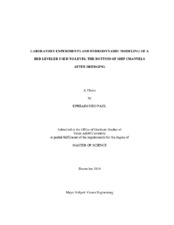| dc.description.abstract | This study was conducted to ascertain the impacts of bed leveling, following ship channel dredging operations, and to also investigate the hydrodynamic flow field around box bed levelers. Laboratory experiments were conducted with bed levelers operating in the laboratory using video cameras for flow visualization. Computer software and numerical codes, called FANS, were used to validate the laboratory experiments.
The study was split into two major parts: laboratory experiments and hydrodynamic modeling. The laboratory experiment was conducted to model how bed levelers interact with the ship channel bottom after hopper dredge dragheads (blades) made passes and created uneven trenches. These interactions were observed using both underwater and hand-held cameras. The hydrodynamic modeling was accomplished using GRIDGEN and PEGSUS commercial software for generating grid and input data files in the pre-processing phase, Finite-Analytic Navier-Stokes (FANS) software for simulation in the processing phase, and two commercial software (Fieldview and Tecplot) for plotting the images and graphs in the post-processing phase.
An interesting phenomenon was observed in the laboratory experimental runs. The flow field showed reversed flow in front of the moving bed leveler and the trench parallel to the direction of the bed leveler. The flow in the parallel trench was observed to be in the same direction as the bed leveler movement, and it was expected that the flow would travel under the bed leveler. The bed leveler was towed at two specified constant speeds: 0.25 m/s (0.82 ft/s) and 0.5 m/s (1.64 ft/s) and at a water depth of 1.22 m (4.00 ft)
Similarly, the images and plots of the hydrodynamic modeling obtained from FieldView and Tecplot software showed flow reversal, depicted by the negative velocities, within the vicinity of the trench, as the model bed leveler moved past and interacted with the fluid. The negative velocity had a magnitude close to 0.5 m/s (1.64 ft/s), which was the velocity used in running the laboratory experiments.
The hydrodynamic simulation matched closely with the experimental observations, and thus, the laboratory observation was confirmed. The final results obtained from the numerical modeling helped to understand the hydrodynamic effects around the box bed leveler. | en |


